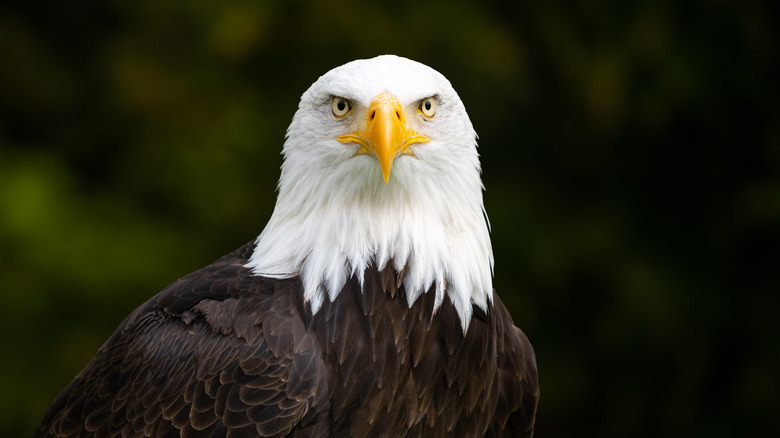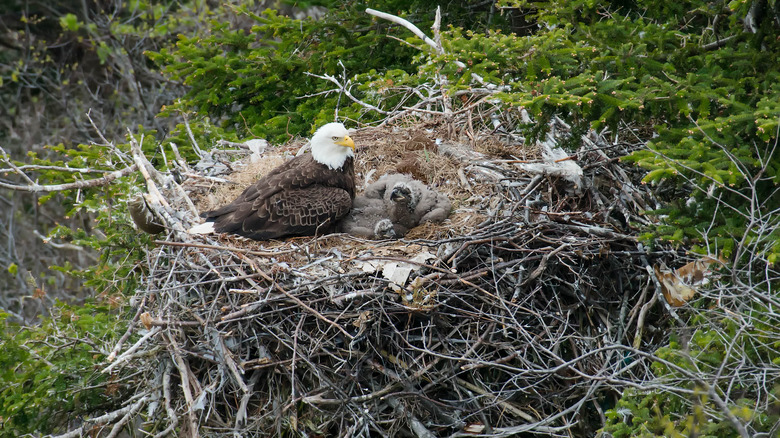The Rules You Need To Follow If You See A Bald Eagle In Nature
Bald eagles are an incredible animal to see in the wild with their majestic white heads and powerful wings. Although these animals were once considered endangered and on the verge of extinction in the late 1970s, hard work by conservation groups and legal protections have helped bring bald eagles back from the brink. Now, they are no longer considered endangered or under threat of becoming endangered at all. While this is great news, more eagles also means that there is a higher chance of stumbling upon one in the wild. If this happens, it's important to know what rules you need to follow to protect the eagles, their habitat, and yourself.
However, before we talk about some rules you should follow when encountering an eagle, it is also important to know when and where you are most likely to come across one so that you know when to be prepared. Bald eagles are often found in forested areas near rivers or lakes because, although they build their nests in trees, their main diet is fish. Although eagles live across the U.S. year-round, you are most likely to see eagles in the winter when they are more active and easier to spot. So, what should you do and not do if you are lucky enough to see a bald eagle in the wild?
Keep your distance
When you see an eagle, the recommended distance to keep between you and the bird is at least a fourth of a mile, as noted by the Department of Environmental Conservation. This is because eagles react very negatively to human interference and have been known to even abandon nests if they feel threatened. Furthermore, during mating season which differs depending on the nesting pair and their location, eagles can become more territorial which may lead to attacks. Eagle attacks are not life-threatening, but the birds do have sharp talons and beaks that can cause some damage.
In a similar vein, it is also important to keep drones at least a quarter mile away from nesting eagles because drone activity near nests can also cause the birds to feel threatened and can lead to nest abandonment. According to the U.S. Fish and Wildlife Service, it is also illegal to follow flying eagles with drones, no matter the distance you keep between the machine and the bird. As it turns out, the best way to observe these birds for their safety and protection is with a good old-fashioned pair of binoculars.
Avoid making loud noises
Similar to how getting too close to eagles can disturb their nesting habits, so can loud man-made noises like those from machines, radios, and even car doors. Therefore, if you know you are in an area that may contain nesting eagles, it is important to be as quiet as possible. This includes refraining from honking, yelling, or playing music from speakers while walking through nature reserves.
This is because the loud noises may startle the birds and cause them to leave their nests. Although the eagles will likely return to their nests later, if this happens often enough it will have negative effects on the bird's young. According to the Audubon Center for Birds of Prey, an eagle that suddenly takes off from its nest may accidentally damage eggs or hurt hatchlings. Furthermore, if these loud startling noises occur often enough and the adult birds are forced to be absent for extended periods, the eggs may die from lack of heat and the hatchlings will be more likely to be picked off by predators.
Never take eagle feathers or bones
While it may seem obvious that federal protections prevent the sale and ownership of any eagle parts dead or alive, what you may not realize is that this law extends to every part of the bird including its bones, nest, and even its feathers. This means that if you come across a dead eagle on the road or even on your property, it is illegal to take anything from the corpse. The only exception to this law is if you belong to a federally recognized Native American tribe. Otherwise, all eagle parts are a big no-no and can, at worst, land you in hot water with the law and, at best, leave you with a hefty fine.
While this law may seem a little antiquated, the purpose behind it is to prevent illegal poaching of eagles for their feathers and to make sure that Native American tribes can still access the feathers for religious ceremonies. So, what should you do if there's a dead eagle in your yard? Immediately call your local wildlife organization which will contact the proper authorities to come and pick up the dead bird and send it to the National Eagle and Wildlife Property Repository for processing. Native Americans from federally recognized tribes may then make requests to the repository for eagle parts to use in religious ceremonies.
Pick up after yourself and leave no trace
If you are spending time birdwatching or hiking in an eagle nesting area, it's also important to pick up after yourself and not leave any food scraps or trash behind. This is because, like many other birds, eagles are drawn to human trash and often spend time picking through waste piles and may even bring some back to their nest to eat. However, easy access to human food and trash can interfere with the natural diet of the birds. Also, as Vice reported, human food products can easily "choke, poison, or otherwise harm eagles."
Therefore, always make sure to throw trash away in the correct bins while in eagle habitat. If you can't find anywhere to leave your trash, you will need to carry it with you until you find a suitable garbage bin. Furthermore, when hunting, it is important to pick up and properly dispose of all animal carcasses. The number one killer of eagles in the U.S. is lead poisoning, which researchers believe occurs when eagles eat the meat of animals that were killed using lead bullets, per NBC.
Report any injured or sick birds
If you come across any injured or sick eagle in your own backyard or while you are out on a hike, it is important to report the bird to the proper authorities. Every state has its own special agencies and centers that deal with caring for and rehabilitating raptors, and you can find out where your nearest center is by contacting your state wildlife agency. If you see that the bird needs immediate care, you can try to transport the bird yourself to a qualified agency. However, it is important to know that even injured eagles have sharp talons and beaks. The American Eagle Foundation recommends using thick gardening gloves and a towel to pick up injured raptors.
The foundation also notes that before attempting to pick up a raptor, you should first make sure it is actually injured. The best way to do this is to walk towards it because healthy eagles will fly away when a human gets too close. If an eagle is not protecting a kill but still does not fly away when approached, it is likely injured or sick.





